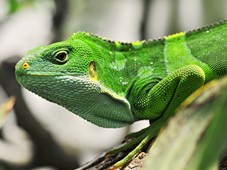
Around 90% of Fiji’s forests are owned by family clans called mataqali, who depend on them for their livelihoods. Half the forests have however been lost through clearance for agriculture, and unsustainable logging from which local people have received little benefit.
Forests are biodiverse ecosystems and provide important ecosystem services (Feld et al. 2009) and livelihoods for the communities that rely on them. Deforestation of Fiji’s forests for agriculture and logging is however risking the resource that communities’ livelihoods and wildlife rely on (Thaman 2002). If managed sustainably benefits can be seen for both biodiversity, ecosystem services and livelihoods.
In 2007, Fiji’s government launched its Forest Policy, aiming to create Permanent Forest Estates (PFE), within which landowners can become long-term beneficiaries of the forestry industry by managing their forests sustainably, or if they choose, can protect their forests permanently.From 2008 to 2011, the Aage V. Jensen Charity Foundation- funded project, Creating Permanent Forest Estates for the Benefit of Fiji’s People and Biodiversity, enabled Fiji’s first national conservation NGO, NatureFiji-MareqetiViti, to raise awareness of the PFE policy among the mataqali. Working alongside Fiji’s Department of Forests, NatureFiji- MareqetiViti held discussions with the owners of nearly 70% of Fiji’s remaining forests.
A second phase of the project, Realising Fiji‘s Dream: Working Towards Sustainable Forest Management for People, for Nature, Forever, focuses on the practical actions required to create Permanent Forest Estates. Mataqali are being given support in managing, monitoring and protecting their forests, and in working with Fiji’s Government towards long-term commitments that will see their traditional rights enshrined in law.
Related Case Studies in other sections
Related Species
Links
References
Compiled: 2015 Last updated: 2015 Copyright: 2015
Recommended Citation:
BirdLife International (2015)
Creating Permanent Forest Estates for the benefit of Fiji’s people and biodiversity.
Downloaded from https://datazone.birdlife.org/sowb/casestudy/creating-permanent-forest-estates-for-the-benefit-of-fiji’s-people-and-biodiversity on 22/12/2024